
Should we always try to eradicate parasites?
Maintaining a healthy gut is essential for overall well-being, as it plays a vital role in digestion, immune function, and nutrient absorption. Unfortunately, our gut health can be compromised by various factors, including the presence of parasites. These unwelcome visitors can disrupt the delicate balance of our gut microbiota and lead to a range of health issues. In this article, we will explore some of the most common parasites that can affect the gut and discuss practical strategies to combat them naturally. Plus we’ll answer the million dollar question – should we always try to eradicate parasites?
Common parasites explained
There are many types of parasites, but the four I most commonly see in clinic are as follows:
Blastocystis hominis
Blastocystis hominis is by far the most controversial, so we’ll start here. This is a single-celled parasite that can cause gastrointestinal symptoms such as diarrhoea, alternating bowel habits, abdominal pain, and bloating. It’s mode of transmission is thought to be faecal to oral. It often hides out in water in warmer climates and can be transmitted into water tanks by birds, therefore when this water is consumed, it lands in your digestive tract. This is what makes it such a common occurrence in the Northern Rivers.
Blastocystis hominis is THE most common parasite found in the Human GIT:
- 30-60% in developing countries
- 1.5-10% in developed countries
- ~ 6% in Australia
Different subtypes are thought to cause different symptoms but pathogenicity is hotly debated. What this means is that Blastocystis hominis doesn’t always need to be treated, and that it can live in harmony as part of a normal, healthy microbiome.
Dientamoeba fragilis
Dientamoeba fragilis is a common parasite associated with gastrointestinal symptoms like diarrhoea, stomach cramps, and fatigue. Transmission is often linked to poor hygiene practices. Again, pathogenicity is debated.
Giardia lamblia
Giardia lamblia is a microscopic parasite that can cause giardiasis, a condition characterised by diarrhoea, greasy stools, abdominal pain, and nausea. It is commonly contracted through contaminated food or water sources. This parasite is considered pathogenic.
Entamoeba histolytica
This parasite causes amoebic dysentery, a severe form of diarrhoea accompanied by blood in the stool. It is typically transmitted through the ingestion of contaminated food or water.
Signs & symptoms of parasites
Identifying the presence of parasites in the gut can be challenging, as symptoms can vary widely or mimic other conditions. However, common signs include:
- Persistent diarrhoea
- Alternating bowel habits (constipation & diarrhoea)
- Bloating
- Abdominal pain
- Weight loss
- Fatigue
- Brain fog
- Skin issues
My general rule is that if you suspect a parasitic infection, test – don’t guess.
How to test for parasites
PCR Faecal Multiplex
The easiest way to test for parasites is to complete a Faecal multiplex PCR. This is a stool sample that looks at the DNA in your stool. PCR stands for Polymerase Chain Reaction technology, which amplifies the DNA of a parasite. This means that the parasite can be dead or in its dormant phase, and it will be detected on this test. This provides more accurate results than microscopy testing (second image below), which only determines parasites that are alive and visible under microscope.
Many GP’s will prescribe a PCR test for you and it will be covered under Medicare. Alternatively this test can be purchased out-of-pocket for around $50.


Microbiome Testing
This is my go-to for testing, because at $350-$400 is gives a far more comprehensive view of the gut. Remember, we not only want to check for parasites, but other common problems that could be causing your symptoms – such as high levels of opportunistic bacteria, or low levels of beneficial bacteria. This imbalance in bacteria is called dysbiosis. Below is a snapshot of the parasite section of a microbiome test.

Three Day Parasite Stool Test
This test requires three separate stool samples that must be sent to a lab for a medical technician to view under a microscope. Parasites have a unique life cycle and can rotate between dormant and active, meaning a technician won’t always be able to see a live parasite in the stool, which is a limitation of this method of testing. For a positive test results, the stool sample must contain a live parasite, which the technician must be able to see it moving. While this can certainly be a useful test, it does not identify dormant parasites, which can cause a number of false-negative test results. This is not a test that I commonly use.
Other Testing Options
Some people say parasites can be determined via kinesiology, hair mineral analysis, and other energetic mediums. These are out of my scope of practice and I’m a believer of science based lab testing, so recommend either PCR testing or microbiome testing with my clients
My story with parasites
My gut health diagnosis began with a positive Blastocystis hominis test. I wish I knew then what I know now, as I swiftly took a course of flagyl, and then did a triple therapy antibiotic treatment recommended by the Centre of Digestive Diseases. Ouch. What I learned through the next few years of gut issues, was that I had a whole lot more going on than just the Blastocystis hominis, and if I have looked with a broader view I may have found my way to health earlier. The power of hindsight…
That being said, I see many clients who feel significantly better when we work on reducing their parasite numbers. Digestive issues, skin issues such as perioral dermatitis, and brain fog all improve. And often quite rapidly. So I believe in looking at the person in front of me, and treating for parasites when indicated.
Parasite treatment goals
Remember, not all bugs are considered pathogenic. Treatment varies depending on what parasite you have, how many you have, and other presenting gut issues.
There are three golden rules when treating parasite infections:
1.Ensure there is no other underlying factor causing your digestive symptoms:
- People are quick to blame their digestive symptoms on parasites. But if you have high level of a parasite and low levels of other beneficial bacteria, trying to eradicate the parasite will likely make your gut health worse. Our goal is to treat the WHOLE gut.
2. Reduce replication and growth to reduce symptoms:
- If symptomatic, do gentle treatment reducing the number of parasites. Eradication is not the goal.
- Many people can live completely asymptomatic with something like Blastocystis hominis on their test result. For those people, treatment is not indicated.
3. Focus on the whole microbiome:
- Next work on building up all other beneficial bacteria, and creating an optimum microbiome environment. This increases your digestive protective mechanisms against future bugs that your system will encounter.
Natural strategies against parasites
Below are some treatments that I use regularly in clinic:
Herbal Remedies
Certain herbs possess potent antimicrobial properties that can help reduce the number of parasites. Examples include black walnut hull, wormwood, cloves, thyme, oregano oil, and allicin. These herbs can be taken in supplement form or used as tinctures under the guidance of a qualified naturopath.
A quick word about the ‘die-off’ reaction. As you begin your parasite treatment, you may experience flu-like symptoms, headaches, brain fog, nausea or bloating, which is part of a common parasite die-off. Parasites can release endotoxins when they die, which your body has to process. If your body is struggling to clear these toxins, you may experience symptoms before they are eliminated. Often a binder supplement such as bentonite clay, is useful to ensure effective and safe clearance.
Supplements
Saccharomyces boulardii has great results in the research and clinically. This is a non-colonising inhibitor, meaning it prevents the parasites from being able to replicate and grow. Another supplement I use regularly is lactulose, which is a prebiotic that helps to acidify the gut. We want the digestive environment to be acidic, and this also prevents parasite growth. Lastly, the probiotic strain Lactobacillus rhamonosus GG is excellent for enhancing defence mechanisms in the gut.
Anti-Parasitic Diet
Adopting an anti-parasitic diet involves avoiding refined sugars, processed foods, and alcohol, as these can feed parasites and weaken the immune system. Additionally, keeping lactose levels low (< 6g/serve) can help to reduce symptoms. Instead, focus on consuming fresh vegetables, fruits, lean proteins, and moderate amounts of healthy fats to create an unfavourable environment for parasites. Adequate fibre helps to acidify the environment, and inhibits the ability for parasites to grow.
Probiotic Foods
A healthy gut microbiota is crucial for warding off parasitic infections. Consuming probiotic-rich foods like yogurt, kefir, sauerkraut, and kimchi can help enhance microbial balance and strengthen the immune system.
Prebiotic Foods
Having plenty of beneficial bacteria as part of your microbiome, is the best way to keep pathogens in check. Incorporating prebiotic-rich foods such as garlic, onions, leeks, asparagus, globe artichokes, legumes, nuts & seeds, and green tea, all help to fuel up your beneficial bacteria.
Hygiene and Sanitation
Practicing good hygiene, such as washing hands regularly, properly washing fruits and vegetables, and avoiding contaminated water sources, is key to prevent parasitic infections. This is especially important when travelling overseas.
Things to avoid when eradicating parasites
- Flagyl, which is an antibiotic, is not an effective strategy against Blastocystis hominis.
- Citrus seed extract, which is damaging to the microbiome when taken internally.
Where to next?
It is important to work with a qualified healthcare professional, such as a naturopath or functional medicine practitioner, for a comprehensive assessment and personalised treatment plan. They can perform appropriate diagnostic tests and prescribe targeted natural therapies to restore your gut health.
If you are experiencing gut symptoms and would like individualised support, please get in touch by booking in a Discovery Call.
Author Brooke Schiller Naturopath & Nutritionist
Brooke is a certified naturopath & clinical nutritionist with a focus on digestive health. Learn more about Brooke here Book a session with Brooke here
References
J Hawrelak The GastroIntestinal Masterclass
https://www.ncbi.nlm.nih.gov/pmc/articles/PMC3745668/
https://pubmed.ncbi.nlm.nih.gov/20922415/





